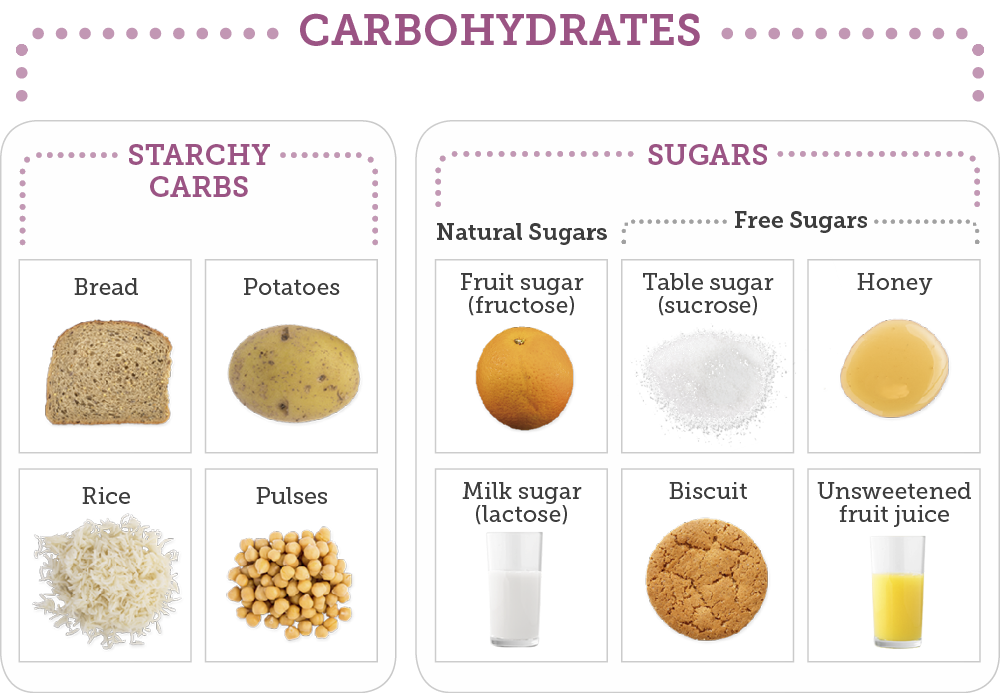Carbohydrates
Contents
- The role of carbohydrates
- Starchy carbohydrates
- Sugary carbohydrates
- Limiting the impact of sugar
- Useful resources
The role of carbohydrates
Carbohydrate is an important source of energy. It comes from two main sources, starch and sugar.

 All types of carbohydrate that you eat and drink are broken down into glucose and will cause a rise in your blood glucose levels.
All types of carbohydrate that you eat and drink are broken down into glucose and will cause a rise in your blood glucose levels.
Starchy carbohydrates
Starchy carbohydrates can be found in bread, rice, pasta, potatoes, cereals, pastry, noodles and flour. Table 1 shows the main sources of starchy carbohydrates. Most of the carbohydrates you eat should be those listed in the right-hand column.
Table 1: Starchy carbohydrates
|
Starchy carbohydrates to limit |
Starchy carbohydrates to choose |
|
Sugar- or honey-coated breakfast cereals |
Wholegrain breakfast cereals e.g. porridge, unsweetened muesli, Shredded Wheat |
|
Potatoes, chips, instant mash |
|
|
Fried rice, pilau rice, naan bread |
Basmati rice, wholegrain rice, wholemeal chapati |
|
White bread, baguettes, rolls |
Wholegrain or seeded bread, baguettes or rolls |
Although certain starchy carbohydrates are healthy foods and should be eaten at each main meal, you should bear in mind the points below:
- Eating carbohydrates of any type will increase your blood glucose levels. The larger the portion, the more your blood glucose will rise. If you eat smaller amounts, however, there will be less of an effect on your blood glucose levels.
- Choosing starchy carbohydrates which contain fibre and whole grains and those that have a lower glycaemic index may have less of an effect on your blood glucose levels as you digest these more slowly. They can also help to keep you feeling fuller for longer, so can help with weight loss too.
- Try to aim for an even distribution of carbohydrate intake throughout the day, rather than saving it all up for one meal. Spreading your carbohydrates through the day normally leads to better-controlled blood glucose levels.
- Eating more carbohydrate than you need will lead to weight gain. If you are trying to lose weight, consider reducing your portion sizes, although if you do, you may need to review your diabetes medication with your care team.
Sugary carbohydrates
Sugar is found in many foods. It can be an added ingredient, e.g. in fizzy drinks, cakes and confectionery, or it can occur naturally in foods such as fruit and milk. Table 2 shows the main sources of sugars, both natural and added. You should try to avoid those in the left-hand column and choose from the foods in the right-hand column as much as possible.
Table 2: Sugary carbohydrates
|
High-sugar items |
Lower-sugar items |
|
Sugar, glucose, golden syrup, dextrose (often found in processed foods), icing sugar, sugar substitutes e.g. Light Spoon, Half Spoon |
Non-nutritive sweeteners, e.g. Canderel, Sweetex, Stevia, Hermesetas, Splenda |
|
Sweet squash, non-diet fizzy drinks, Ribena, energy drinks e.g. Lucozade, Red Bull, Gatorade, drinking chocolate |
Diet/light/zero fizzy drinks, no added sugar squash, low-sugar drinking chocolate (always check the label for the ingredients) |
|
Sweets, chocolate, fudge, tablet, mints, chocolate and cream-filled biscuits, marzipan |
Plain biscuits, crackers, oatcakes |
|
Sugar- or honey-coated breakfast cereals e.g. Coco Pops, Frosties, Crunchy Nut Cornflakes |
Wholegrain, no-added-sugar breakfast cereals with no dry fruit added, e.g. Shredded Wheat, Bran Flakes, porridge, unsweetened muesli with nuts |
|
Cakes, cheesecakes, crumbles, pastries, ice cream, milk puddings, tinned fruit in syrup |
Fresh fruit, natural yoghurt, tinned fruit in natural juice |
|
Marmalade, jam, honey, syrup |
A thin scraping of reduced-sugar jam or marmalade |
The safety of non-nutritive sweeteners is an ongoing topic of debate. All the sweeteners listed have undergone rigorous safety checks. It is your choice whether to include them in your diet, but it is always advisable to check food labels on everything you eat and ensure that you only eat them in limited amounts. You should avoid eating or drinking anything containing aspartame as it is not recommended for people with diabetes.
Limiting the impact of sugar
Although you should limit how much added sugar you eat or drink, you can still enjoy the occasional treat. The following tips may help you to limit the impact on your blood glucose levels.
Reduce the total carbohydrate
It is the total amount of carbohydrate (starch and sugar) and the type (low or high glycaemic index) that will affect your blood glucose. So if you do have a dessert after your evening meal, the total amount of carbohydrate you eat will be higher, which is likely to cause raised blood glucose levels. To minimise this, you could have a smaller portion of starchy food and/or dessert.
Be more active
If you are able to increase your activity or do some exercise after having a treat or dessert this can help minimise the rise in your blood glucose levels. This is because activity helps your body use insulin better to lower your blood glucose levels. Of course, this can also help you manage your weight.
Adjust your diabetes medication
Diabetes managed with insulin allows you some flexibility to adjust your dose according to your food choices. If you wish to pursue this option, speak with your diabetes care team.
Useful resources
Carbs & Cals is a useful resource to help you identify the carbohydrate content in foods. All images used above are courtesy of Carbs & Cals.
For more information about other aspects of your diet see Fats, Oils and Spreads; Fibre and Wholegrains; Fruit and Vegetables; and Salt.

